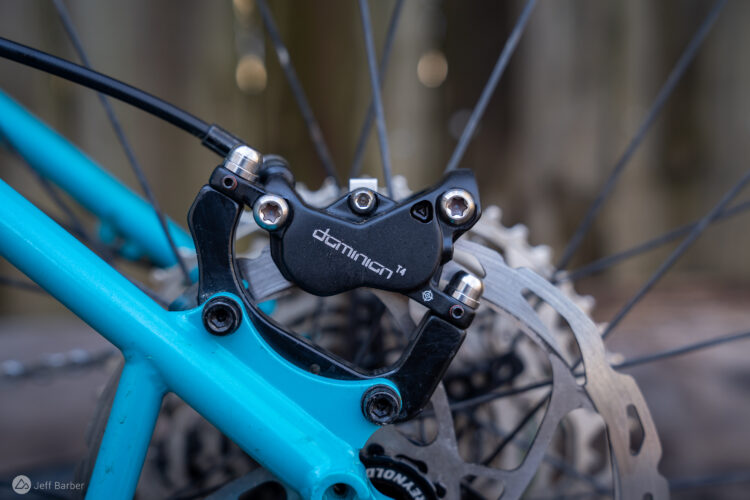
After finding the stock brakes on my new eMTB under-powered, I decided to give the Hope Tech 4 V4 brakes a try. This is the Barnoldswick-based component company’s most powerful disc brake model yet so I had high hopes.
The glut of supply following the post-pandemic bike boom produced some eye-popping deals on bikes. Unable to resist a good sale, I pulled the trigger on a Specialized Turbo Levo in late 2022. I’m clearly not the only one who’s taken the plunge, and in a recent Singletracks poll on e-bike ownership, 68% of you reported owning one.
Ignoring the fact that it does virtually nothing for fitness (if we’re being honest), e-biking has taught me a ton about riding. The trail comes at you fast when you’re armed with 90Nm of torque and 565 watts of power, and while SRAM Code brakes have always tamed my trail bike antics with little effort, on an e-bike it’s a different story.
Combine overall increased trail speed with the hefty, 50+ pound weight of a full-power e-bike and it’s no surprise the Code RS brakes specced on my steed could be a little underwhelming.
Hope Tech 4 V4 brakes key specs
- Weight: 310g per side, uncut hoses
- Price: $265-300 per side
- Buy from Backcountry and JensonUSA


Hope was built around disc brake systems, launching its first hydraulic version way back in 1994. That pedigree is obvious from the first glance at these shiny silver stunners, and their beautifully machined lines and steampunk vibe clearly originated in the same place that spawned the industrial revolution.
On the control end, the Hope Tech 4 V4s don’t so much sit on your handlebars as adorn them. The machined lever blade feels great ergonomically, and it includes two dials that offer a substantial range of tool-free adjustment for reach and bite point. A hinged clamp allows you to adjust or remove the lever with a single bolt without messing with the rest of your controls, and I found the long lever enabled me to mount the brakes farther inboard than some brands, reducing interference with other controls in the cockpit and negating the need for creative mounting solutions. If your situation differs, Hope offers a variety of adapters to play nicely with common shifter options.

On the business end, the calipers completely dwarf the Codes they replaced, and I wouldn’t be surprised if they could stop a wheel with intimidation alone. Plenty of surface area is machined in to keep things cool, and the caliper utilizes four chunky, stainless steel pistons — two 18mm and two 16mm — with phenolic inserts designed to effectively manage heat buildup.
All Hope Tech 4s ship with two-meter hoses, meaning you’ll likely need to trim and bleed both the front and rear. Luckily, bleeding follows the same simple procedure as most motocross or automotive brakes and requires no special kit, although the one provided by Hope could speed up the process. I found bleeding the brakes about as easy if a little messier than the SRAM process I’m much more familiar with.
All Hope brakes use DOT 5.1 brake fluid, which isn’t a particularly surprising choice considering the local meteorology. The UK has a reputation for ample rain and moist trails, and the hydrophobic nature of mineral oil means it doesn’t mix with moisture, both literally and figuratively.



On the trail
So how do they perform? The sealed bearings in the long lever give the Hope Tech 4s a very smooth and light feel, and perhaps as a result the first bite of the pads is subtle. In fact, the modulation was a little unnerving as I was building trust in the brakes. Fortunately, when I reached a crest and the bottom dropped out on a 2,000-foot descent, I discovered the vast reserve of power hidden behind that initial nibble at the rotor.
Speaking of rotors, I paired the calipers with Hope’s floating 1.8mm rotors, which come in a variety of anodized colors and generally retail for about $65 here in the states. These days many brands are opting for a thicker rotor, and Hope even makes a vented 3.3mm rotor they claim manages extreme moisture and reduces heat by 15%. However, the company suggests that the aluminum center of the more conventional 1.8mm floating rotor is both stiff enough and offers a sufficiently large heat sink to render additional thickness of the stainless steel braking surface unnecessary.
Share your Hope Tech 4 V4 review
This claim held true in my experience, and the beefy brakes paired with 200mm rotors proved to be more than sufficient to control both the 29” front wheel and 27.5” rear of the Turbo Levo. Given how easy it already is to lock up either wheel, I’d imagine only the most demanding riders (and the biggest) should consider sizing up to 220mm rotors. Spending time on the Tech 4s really made me realize how much of a deathgrip I’d previously been using to try and control my speed, and the ratio of effort-to-output the Tech 4s unlock was a little disconcerting until I became accustomed to it. Now, there’s no looking back.

Pros and cons of Hope Tech 4 V4 brakes
Pros
- Ample power for any application
- Readily available parts and instructions for rebuilding
- Wide range of adjustability
- Three sets of pads included with each brake
- Reasonable weight (~310g/ea with uncut 2-meter hoses, comparable to Codes)
Cons
- All the power on tap comes with a learning curve
- Bleed process is messier than brakes that use syringes
Bottom line
My first foray into boutique brakes is also the best experience I’ve had with stoppers so far. The excellent modulation the Hope Tech 4s offer and the minimal effort they require make controlling a big bike on big terrain as easy as possible, letting you focus on the ride instead of trying not to crash.





















6 Comments
Aug 2, 2024
Not degassing fluid results in a less than optimum lever feel and function. It also will have folks doing another bleed in a few weeks. Do it right from the start...
Aug 1, 2024
But why spread false info about ebike exercise benefits?:
"Ignoring the fact that it does virtually nothing for fitness (if we’re being honest), e-biking has taught me a ton about riding."
Here's a link to one of many studies showing emtb benefits are significant:
https://www.ncbi.nlm.nih.gov/pmc/articles/PMC6711045/
Aug 1, 2024
Aug 1, 2024
After a full season of e-biking pretty much as hard as I could (and telling lots of people who didn't ask what a good workout it was), switching back to the analog bike was eye-opening to say the least.
I've found Strava's "Relative Effort" score to be a pretty accurate gauge of my exertion on a given ride, and for me that score is generally 90% lower on e-bike rides. The fact that the linked study shows a 10bpm reduction in heart rate is also very inconsistent with my own experience, where heart rate is roughly cut in half on the e-bike.
It could be that the 2019 study featured lightweight (and reduced power) e-bikes, or just that e-bikes at that time were less powerful than the latest generation. Just speculation, but it's interesting for sure!
Aug 6, 2024
Aug 16, 2024